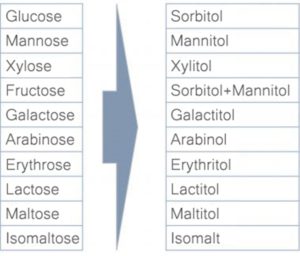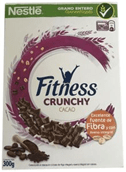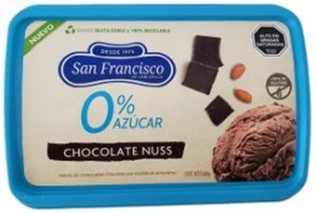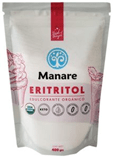
Erythritol, a natural sugar substitute solution
Traditionally, the most widespread sweeteners in food products have been sugar or sucrose. The search for a healthy diet has focused on limiting their consumption, and it has been an undeniable challenge for the industry for a long time now.
Many food-related scientific studies focus on finding new ways to replace sugar, both for its direct consumption, and for reducing its content in formulations when developing other products, where, depending on the food type, sugar can provide characteristics such as structure, body and moisture, among others, in addition to its sweetness.
There is a long list of ingredients and additives that have been used to replace sugar—from synthetic products such as aspartame and saccharin, to 100% natural ingredients such as certain dried or powdered fruits. While the latter are seen in a better light by consumers, often times they are not suited to the needs of industrial production lines.
Polyols are among the natural ingredients that have performed well in the industry when formulating low sugar or sugar-free products.
What are polyols?
Polyols, also known as sugar alcohols, are neither sugars nor alcohols, but instead are the hydrogenated form of a carbohydrate, where a carboxyl group, whether aldehyde or ketone, is reduced into a primary or secondary hydroxyl group1,2. As a result, each sugar has its corresponding polyol, as shown in the graph below.

Polyols are naturally abundant in fruits and vegetables such as grapes and champignons, as well as in fermented foods such as soy sauce and red wine3. In general, its presentation is in the form of a white, crystalline powder, or of transparent syrups. The main interest in its use lies in the physical, chemical and biological properties of these compounds:
- They lack cariogenic capabilities since they are not metabolized by most tooth plaque microorganisms
- Their metabolization does not depend on insulin
- Their intake does not lead to significant glycemic increases
- They have good water binding capabilities in foods
- The syrups in particular have low viscosities, which make them easy to handle in production lines4
Erythritol, a special polyol
Out of all the sugar alcohols, Erythritol (Erythrol, Threitol or E968) has the lowest molecular mass at just four carbon atoms—a fact that is linked to particular physical and chemical properties. Its sweetness is 0.6 to 0.8 times that of sucrose and, being heat-positive, it gives off a feeling of coolness when dissolved in the mouth2,3.
In nature, it can be found in fruits such as pears, grapes and melons, while in industry it is obtained through the fermentation of sugars using yeasts, being the only polyol that is obtained by means of this process2,5.
One of the most important characteristics of erythritol is that it can improve the mouthfeel and mask certain undesired aftertastes, such as astringency and the irritant effect of intense sweeteners6. In addition, it is the only polyol considered to be non-caloric since it does not provide energy to the body, making it the best alternative when formulating foods aimed at diabetics or people with obesity.
Another one of the main characteristics of erythritol is its high digestive tolerance. This molecule can be easily absorbed in the intestine and, unlike polyols, it has a high laxative threshold, meaning that it does not cause intestinal discomfort3.
Current landscape for Erythritol
In 2003, the use of erythritol was approved in the entire European Union for food products as a sweetener and chewing gum moisturizer. In 2015, erythritol was approved as a flavor booster in non-alcoholic drinks7. Today, the use of erythritol has been approved in over 60 countries3, and currently in Chile it is authorized as a moisture-stabilizing substance, bulking agent and/or sweetener in the food health regulations.
In a report published last month, Mintel informed that erythritol is becoming increasingly popular in launches with low-sugar claims. It was reported that the percentage of foods and drinks that contain erythritol rose by 7% in the last year8. This same publication shows a growth in bulking sweeteners, such as erythritol, as solutions for sugar reduction.
Another important aspect that was also mentioned in Mintel’s report is the need for the industry to advocate for, and educate about, these new ingredients in order to bring these new technologies to the consumer in a way that is clear and well-informed. Erythritol can be used in a wide range of solid and liquid formulations in the food industry, such as beverages, dairy products, baked products, confectionery, chocolates, frozen products and even for direct use. Below we show you a few examples on the market that use erythritol.
At MATHIESEN FOOD, we carry a wide range of sweeteners including erythritol, either pure or mixed with other natural sweeteners, specifically designed to offer a solution to the challenges posed by each development. If you have yet to try erythritol and are interested in knowing more about the benefits of using this natural sweetener, contact us and ask for a sample.
(1) Ghosh, S., & Sudha, M. L. (2012). A review on polyols: new frontiers for health-based bakery products. International journal of food sciences and nutrition, 63(3), 372–379.
(2) http://milksci.unizar.es/bioquimica/temas/azucares/polialcohol.html
(3) Regnat, K., Mach, R. L., & Mach-Aigner, A. R. (2018). Erythritol as sweetener-wherefrom and whereto?. Applied microbiology and biotechnology, 102(2), 587–595.
(4) Bello Gutiérrez, J. (2000). Ciencia bromatológica: principios generales de los alimentos. Ediciones Díaz de Santos. Pag 103-105
(5) Lin SJ,Wen CY, Liau JC, Chu WS. 2001. Screening and production of erythritol by newly isolated osmophilic yeast-like fungi. Proc Biochem 36:1249–1258.
(6) de Cock P (2012) Erythritol sweeteners and sugar alternatives in food technology. Wiley-Blackwell, Hoboken, pp 213–241
(7) Ingredient Watch: Erythritol needs an image boost. Mintel, NOVEMBER 2022.




















